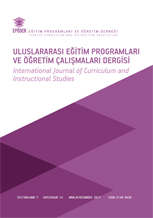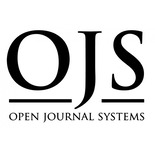Developing the Historical Thinking Skill Scale at the Secondary School Level
Abstract
This research aims to develop a set of scales that will allow the measurement of historical thinking skills of secondary school students. Expert opinion was used for the content and face validity of the scale, Exploratory Factor Analysis (EFA) and Confirmatory Factor Analysis (CFA) were used for the construct validity. A total of 817 students participated in the study, 497 of which were in the EFA study and 320 in the CFA study. As a result of EFA, a three-factor structure was obtained for each subscale which explained 55.57% of the total variance for the time and chronology perception (TCP) subscale; 52.04% of the total variance for the historical empathy (HE) subscale; and 49.01% of the total variance for the historical inquiry (HI) subscale. Findings from CFA showed that the subscales had sufficient fit indices and their reliability coefficients were within acceptable limits. Findings reveal that the scale can be used as a valid and reliable tool in determining students' historical thinking skills.
Downloads
References
Akıncı-Güngör, B. A., & Dilek, D. (2012). Improving the historical thinking skills by using representative pictures during social studies teaching. Marmara University Atatürk Education Faculty Journal of Educational Sciences, 36(36), 5-27.
Aktın, K. (2017). Development of the historical thinking skills of children with museum education in pre-school period. Mersin University Journal of the Faculty of Education, 13(2), 465-486. http://dx.doi.org/10.17860/mersinefd.304070
Bartelds, H., Savenije, G. M., & Van Boxtel, C. (2020). Students’ and teachers’ beliefs about historical empathy in secondary history education. Theory & Research in Social Education, 48(4), 529-551, https://doi.org/10.1080/00933104.2020.1808131
Barton, K. C., & Levstik, L. S. (2004). Teaching history for the common good. Mahwah, NJ, US: Lawrence Erlbaum Associates Publishers.
Bell, A. (2007). Designing and testing questionnaires for children. Journal of Research in Nursing, 12(5), 461-469.
Büyüköztürk, Ş. (2015). Sosyal bilimler için veri analizi el kitabı. Ankara: Pegem Akademi Yayınları.
Çalışkan, H., & Demir, B. (2019). Development of historical empathy scale for adolescents: validity and reliability study. Turkish History Education Journal, 8(1), 129-149.
Çelikkaya, T., & Kürümoğlu, M. (2017). Status of use in books field skills of the gained targeted in the 2005 social studies curriculum. Mustafa Kemal University Journal of Social Sciences Institute, 14(40), 141-158.
Çelikkaya, T., & Boyraz, F. (2018). Reflection of evidence based teaching on the 2005 teacher guide books in social studies curriculum. Kastamonu Education Journal, 26(4), 1227-1236. https://doi.org/10.24106/kefdergi.434153
Chapman, A. (2011). Taking the perspective of the other seriously? Understanding historical argument. Educar em Revista, 42, 95-106, https://doi.org/10.1590/S0104-40602011000500007
Chowen, B. W. (2006). Teaching historical thinking: What happened in a secondary school world history classroom. (Unpublished doctoral thesis). The University of Texas at Austin, ABD.
Çiviler, M. (2019). Developing students' historical thinking skills in 7th grade social studies course at secondary school: An action research. (Unpublished masters’s thesis). Marmara University, İstanbul, Türkiye.
Çobanoğlu, R., & Yıldırım, A. (2021). Curriculum development studies in Turkey: A historical analysis from the declaration of republic to present. The Journal of Turkish Educational Sciences TEBD, 19(2), 810-830, https://doi.org/10.37217/tebd.912329
Coltham, J. B., & Fines, J. (1971). Educational objectives for the study of history, London: Historical Association.
Çulha-Özbaş, B. (2010). Progression in historical thinking among students ages 12-14 and using historical evidence. (Unpublished doctoral thesis). Dokuz Eylül University, İzmir, Türkiye.
De Leur, T., Van Boxtel, C., & Wilschut, A. (2015). Just imagine: Students’ perspectives on empathy tasks in secondary history education. International Journal of Historical Learning, Teaching and Research, 13(1), 69-84.
Demircioğlu, İ. H. (2009). Perceptions of history teachers about historical thinking skills. Milli Eğitim Dergisi, 39(184), 228-239.
Demircioğlu, İ. H., & Akengin, H. (2011). Zaman ve mekâna ilişkin becerilerin öğretimi, C. Öztürk (Ed.), Sosyal bilgiler öğretimi (ss.187-224) içinde, Ankara: Pegem A Yayıncılık.
Devellis, R. F. (2021). Ölçek geliştirme: Kuram ve uygulamalar (T. Totan, çev ed.). Ankara: Nobel Akademik Yayıncılık.
Dilek, D. (2002). Tarih derslerinde öğrenme ve düşünce gelişimi: Ankara: Nobel Yayıncılık.
Drake, D. F., & Nelson, L. R. (2008). Engagement in teaching history (2nd ed.). New Jersey: Pearson.
Drake, F. D., & Brown, S. D. (2003). A systematic approach to improve students’ historical thinking. The History Teacher, 36(4), 465-489.
Endacott, J., & Brooks, S. (2013). An updated theoretical and practical model for promoting historical empathy. Social Studies Research and Practice, 8(1), 41-58.
Ercikan, K., & Seixas, P. (2015). Issues in designing assessments of historical thinking. Theory into Practice, 54(3), 255-262, https://doi.org/10.1080/00405841.2015.1044375
Ercikan, K., Seixas, P., Lyons-Thomas, J., & Gibson, L. (2015). Cognitive validity evidence for validating assessments of historical thinking. In New directions in assessing historical thinking (pp. 228-242), Routledge.
Fraenkel, J. R., Wallen, N. E., & Hyun, H. H. (2012). How to design and evaluate research in education (8th ed.). New York: McGraw-Hill.
Gürsoylar, G. (2019). The use of historical empathy in teaching cultural and heritage learning area in secondary school 7th grade social studies course: An action research. (Unpublished masters’ thesis). Marmara University, Istanbul, Türkiye.
Gutwill, J. P., & Allen, S. (2012). Deepening students’ scientific inquiry skills during a science museum field trip. Journal of the Learning Sciences, 21(1), 130-181. http://dx.doi.org/10.1080/10508406.2011.555938
Hicks, D., & Doolittle, P. E. (2008). Fostering analysis in historical inquiry through multimedia embedded scaffolding. Theory and Research in Social Education, 36(3), 206-232. https://doi.org/10.1080/00933104.2008.10473373
Ho, R. (2006). Handbook of univariate and multivariate data analysis and interpretation with SPSS. New York: Chapman & Hall/ CRC Taylor and Francis Group.
Huijgen, T., Van Boxtel, C., Van de Grift, W., & Holthuis, P. (2017). Toward historical perspective taking: Students’ reasoning when contextualizing the actions of people in the past. Theory & Research in Social Education, 45(1), 110-144, https://doi.org/10. 1080/00933104.2016.1208597
Kabapınar, Y. (2007). İlköğretimde hayat bilgisi ve sosyal bilgiler öğretimi. Ankara: Maya Akademi.
Karabağ, Ş. G. (2003). The historical empathy as a teachable and a cognitive skill. (Unpublished doctoral thesis), Gazi University, Ankara, Türkiye.
Karagöz, Y. (2017). SPSS ve amos uygulamalı nitel-nicel-karma bilimsel araştırma yöntemleri ve yayım etiği. Ankara: Nobel Akademik Yayıncılık.
Keçe, M. (2015). Comparison of historical thinking skills with historical literacy skills, Karadeniz Sosyal Bilimler Dergisi, 7(3), 108-122.
Kıcır, K. (2006). Pupil's levels of historical learning skills in seventh grade social studies lessons. (Unpublished master’s thesis). Marmara University, Istanbul, Türkiye.
Kline, R. B. (2016). Principles and practice of structural equation modeling. New York: The Guilford Press.
Kohlmeier, J. (2006). “Couldn’t she just leave?”: The relationship between consistently using class discussions and the development of historical empathy in a 9th grade world history course. Theory & Research in Social Education, 34(1), 34-57, http://dx.doi.org/10. 1080/00933104.2006.10473297
Lee, P., & Ashby, R. (2001). Empathy, perspective taking and rational understanding. In O. L. Davis Jr., E. A. Yeager & S. J. Foster (Eds.), Historical empathy and perspective taking in the social studies (pp. 21-50). Lanham, MD: Rowman & Littlefield Publishers Inc.
Leinhardt, G., & Young, K. M. (1996). Two texts, three readers: Distance and expertise in reading history. Cognition and Instruction, 14(4), 441-486.
Levesque, S., & Clark, P. (2018). Historical thinking: Definitions and educational applications. In S. A. Metzger & L. McArthur Harris (Eds.), The Wiley international handbook of history teaching and learning (pp. 119–148). Hoboken: John Wiley & Sons, Inc.
Marsh, H. W., Hau, K. T., Artelt, C., Baumert, J., & Peschar, J. L. (2006). OECD’s brief self-report measure of educational psychology’s most useful affective constructs: Cross-cultural, psychometric comparisons across 25 countries. International Journal of Testing, 6(4), 311-360. https://doi.org/10.1207/s15327574ijt0604_1
McCully, A., Pilgrim, N., Sutherland, A., & McMinn, T. (2002). Don’t worry, Mr. Trimble. We can handle it ‘balancing the rational and the emotional in teaching of contentious topics. Teaching History, 106, 6-12.
Meydan, C. H., & Şeşen, H. (2015). Yapısal eşitlik modellemesi amos uygulamaları. Ankara: Detay Yayıncılık.
Meyers, L. S, Gamst, G., & Guarino, A. J. (2006). Applied multivariate research: Design and interpretation. London: SAGE Publications.
Ministry of National Education [MoNE], (2005). Social studies lesson in primary education, 6th and 7th grades curriculum and guide. Ankara: Publications of the Directorate of State Books.
Ministry of National Education [MoNE], (2018). Social studies course curriculum (4, 5, 6, 7 grades). Retrieved from http://mufredat.meb.gov.tr/ProgramDetay. aspx?PID=354
National Council for the Social Studies [NCSS], (1994). Expectations of excellence: Curriculum standarts for social studies. Washington: National Council for the Social Studies.
National Standards for History [NCHS], (1996). Basic Edition. In U. O. California (Ed.), National Standards for History. University of California: Center for History in the Schools.
Orçan, F. (2018). Exploratory and confirmatory factor analysis: which one to use first? Journal of Measurement and Evaluation in Education and Psychology, 9(4), 413-421. https://doi.org/10.21031/epod.394323
Özen, R. (2010). Primary education 7. grade students time, permanence and change investigetion of skills: Qualitative a research. (Unpublished masters’ thesis). Sakarya University, Sakarya, Türkiye.
Pallant, J. (2005). SPSS survival manual: A Step by guide to data analysis using SPSS for windows (2nd ed.). National Library of Australia.
Safran, M., & Şimşek, A. (2006). Development of historical time concept in elementary school’s students. Elementary Education Online, 5(2), 87-109.
Sağlam, H., Tınmaz, E., & Hayal, M. (2015). A Phenomenological perspective on teaching experiences of perception skills of “time and chronology” of classroom teachers. Turkish History Education Journal, 4(1), 49-66, https://doi.org/10.17497/tuhed.185616
Schermelleh-Engel, K., & Moosbrugger, H. (2003). Evaluating the fit of structural equation models: Tests of significance and descriptive goodness-of-fit measures. Methods of Psychological Research Online, 8(2), 23-74.
Schumacker, R. E., & Lomax, R. G. (2010). A beginner’s guide to structural equation modeling (3th ed.). New York, NY: Taylor and Francis Group.
Seçer, İ. (2015). SPSS ve lisrel ile pratik veri analizi: Analiz ve raporlaştırma. Ankara: Anı Yayıncılık.
Seixas, P. (2001). Review of research on social studies. Handbook of research on teaching, 4, 545-565.
Seixas, P. (2012). Progress, presence and historical consciousness: Confronting past, present and future in postmodern time. Paedagogica Historica, 48(6), 859-872, https://doi.org/10.1080/00309230.2012.709524
Seixas, P. (2017). A model of historical thinking. Educational Philosophy and Theory, 49(6), 593-605, https://doi.org/10.1080/00131857.2015.1101363
Seixas, P., & Colyer, J. (2011). Assessment of historical thinking. New possibilities for the past. Shaping History Education in Canada, 139-153.
Seixas, P., & Peck, C. (2004). Teaching historical thinking. In A. Sears & I. Wright (Eds.), Challenges and prospects for Canadian social studies (pp. 109-117). Vancouver: Pacific Educational Press.
Şimşek, A. (2006a). The opinions of students about historical story in social studies in elementary schools. Gazi Eğitim Fakültesi Dergisi, 26(1), 187-202.
Şimşek, A. (2006b). İlköğretim öğrencilerinde tarihsel zaman kavramının gelişimi ve öğretimi. (Unpublished doctoral thesis). Gazi University, Ankara, Türkiye.
Şimşek, A. (2007). İlköğretim 5. sınıf öğrencilerinin kronolojik algılarının geliştirilmesine yönelik yarı deneysel bir çalışma. Kuram ve Uygulamada Eğitim Bilimleri, 7(1), 589-615.
Şimşek, A. (2009). İlköğretim öğrencilerinde tarihsel zaman ve kronoloji becerileri. M. Safran (Ed.), Sosyal bilgiler öğretimi içinde (ss. 92-113). Ankara: Pegem A Yayıncılık.
Şimşek, A. (2017). 2017 Taslak Tarih 9-10-11, Türk kültür ve medeniyet tarihi öğretim programlarının eleştirisi. Turkish History Education Journal, 6(1), 140-162.
Şimşek, A., & Kolbasar, S. (2020). Investigation of the “national struggle” subject in the 4th grade social studies book in term of teaching chronology knowledge and skills with teacher and students opinions, International Journal of New Approaches in Social Studies (IJONASS), 4(2), 335-356 https://doi.org/10.38015/sbyy.842634
Sipahi, B., Yurtkoru, S., & Çinko, M. (2010). Sosyal bilimlerde SPSS’le veri analizi. İstanbul: Beta Basım Yayım Dağıtım.
Tabachnick, B. G., & Fidell, L. S. (2013). Using multivariate statistics. Boston: Pearson Education, Inc.
Varlıkgörücüsü, N., & Çalışkan, M. (2020). How can I improve the ability to perceive time and chronology? Journal of Ahmet Kelesoğlu Education Faculty, 2(2), 194-209. https://doi.org/ 10.38151/akef.2020.4
Weston, R., & Gore, P. A. (2006). A brief guide to structural equation modeling. The Counseling Psychologist, 34(5), 719-751, https://doi.org/10.1177%2F0011000006286345
Willis, G. B. (2004). Cognitive interviewing: A tool for improving questionnaire design. City: Sage Publications.
Wineburg, S. (2007). Unnatural and essential: The nature of historical thinking. Teaching History, 129, 6-12
Yeşil, R. (2010). Questioning-based learning in history education, Ahi Evran Üniversitesi Kırşehir Eğitim Fakültesi Dergisi, 11(2), 119-137.





